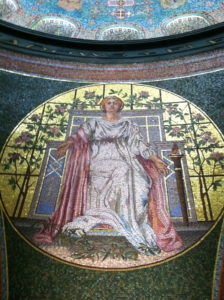There is a small chapel in a cemetery in Minneapolis that is truly remarkable. Styled after the Hagia Sophia in Istanbul, a very early Christian structure, this referencing chapel in Minneapolis is a jewel box.
The interior mosaics are stunning, crafted by Italian artisans, who pieced over 10 million tiles into visuals! It is said that this interior is the most perfect replication of Byzantine mosaic art in our country (that’s not saying much! But this work easily rivals the mosaics in Ravenna and Venice). The focus of all the decorative work is the placement of four large personifications, four graces as it were. These represent MEMORY, FAITH, HOPE and LOVE. Each personification is labeled so the symbolism is not missed, and each figure is over 7 feet tall. Clearly the personifications are placed in a definite and progressive order from the front left of the chapel around clockwise to the back. We remembered my Dad before his burial from this chapel and now my Mom.
The beauty of this entire space is incredible and of course therefore a tonic in grief for so many who pass through. I am struck by how these four personifications summarize the process of valuing a life, no matter whose life. These were placed to be a visual tableau. One could miss their instructive value even while noting their incredible visual power. When my Dad died in 1985, the events somewhat blinded me from pondering these. But I remember the beauty and I kept the brochure. Preparing for my Mom’s funeral, I spent time considering the import of these four personified ideas: Memory, Faith, Hope and Love. These words and images corresponded with, and reinforced some important reading I have been doing. Mom would have loved the discussion in her more vital years.
MEMORY: I miss those years with Mom and have so many good memories of her significant mark on my life.
FAITH: Mom became a woman of faith in her mid-fifties as a result of great trauma with one of my siblings. It was the significance in the suffering that Jesus accomplished that got Mom’s attention, and her allegiance. She went from being a casual churchgoer to a hungry believer. These two ideals, Memory and Faith, my Mother accomplished so well.
HOPE: The back of the room reveals the potential of life’s journey after faith has been grasped. Hope springs from faith; it is a sure confidence (the word is a compound that means literally “with faith”). True Biblical hope is grounded in what has been accomplished to buy our rescue. Jesus now promises to bind up the believer’s wounds, to make final sense of every sorrow, to deal justly with every evil, and to lift us out of our own death in time.  This is not empty wishing; it is solid unseen trust.
This is not empty wishing; it is solid unseen trust.
LOVE: This last idea, pictured here, is the greatest. Yet it is not prominent; it almost sits shyly in the back until noticed, until mourners are walking out. Love is realized after lived-out hope. The gaze of each of the personifications in the room is noteworthy: Memory ponders, looking downward. Faith looks intently away. Hope looks upward. Love alone looks directly forward. I am most moved by this. She looks right into you and keeps on looking. She is straightforward, while gentle. She is at ease but also very courageous. Her gaze penetrates time: past, present and future. I know few who practice love like this. I know only One who lived like this.